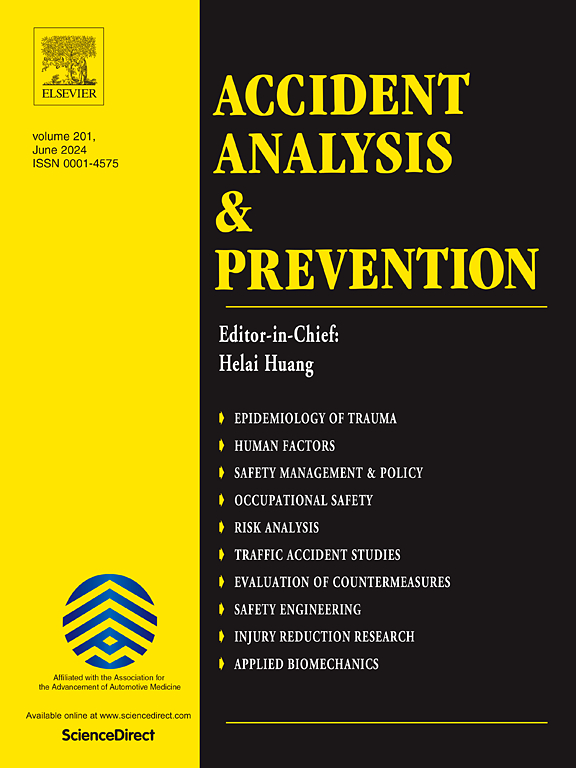夜间行人安全:行人自动紧急制动系统的作用
IF 5.7
1区 工程技术
Q1 ERGONOMICS
引用次数: 0
摘要
易受伤害的道路使用者(例如行人)死亡人数的上升令人震惊。夜间在行人撞车事故的风险因素中构成了独特的挑战,约占美国死亡人数的74%。安全车辆是安全系统方法的一个关键要素,是改善行人安全的一个有希望的解决方案。车辆自动化,特别是行人自动紧急制动(P-AEB)系统,可以减少行人撞车事故。然而,P-AEB系统的有效性,特别是在黑暗中,仍然不确定。通过分析最近美国公路安全保险协会(Insurance Institute for Highway Safety)从2021年到2023年的夜间数据集,结合车辆数据创建一个独特的数据库(1973年的现场测试),本研究旨在了解P-AEB系统在夜间的有效性,并探索其性能的相关性,特别是前照灯技术、所使用的传感器、车辆推进类型(电动汽车(ev)与非电动汽车)的作用。并将整车重量和尺寸控制在实验数据范围内。利用随机效应的Heckman样本选择模型和面板数据,该研究估计了碰撞情况下的碰撞概率和碰撞速度,解决了数据固有的面板结构和不同车辆和场景之间未观察到的异质性。统计数据表明,在63.6%的情况下,P-AEBs使车辆停下,平均使撞车速度降低了33.12%。结果表明,P-AEBs在使用发光二极管大灯的车辆中比使用卤素大灯的车辆表现更好,但在更大、更重的汽车和电动汽车中可能效果相对较差。此外,集成摄像头和雷达传感器提高了p - aeb的可靠性,而不是仅仅依赖摄像头。未来的工作可以通过专注于先进的前照灯技术和传感器集成,改进P-AEBs在各种场景下的预测算法,以及解决系统在大型、重型车辆和电动汽车中的局限性,来提高夜间行人的安全性。本文章由计算机程序翻译,如有差异,请以英文原文为准。
Nighttime safety of pedestrians: The role of pedestrian automatic emergency braking systems
The rise in vulnerable road user fatalities, e.g., pedestrians, is alarming. Nighttime poses unique challenges among the risk factors in pedestrian-involved crashes, accounting for approximately 74% of fatalities in the United States. Safe vehicles, a key element of the Safe System Approach, are a promising solution to improve pedestrian safety. Vehicle automation, particularly Pedestrian Automatic Emergency Braking (P-AEB) systems, can mitigate pedestrian-involved crashes. However, the P-AEB systems’ effectiveness, especially in darkness, has remained uncertain. Through analyzing the recent Insurance Institute for Highway Safety nighttime dataset from 2021 to 2023, integrated with vehicle data to create a unique database (1973 field tests), this study aims to understand the P-AEB systems’ effectiveness at night and explore correlates of their performance, especially the role of headlight technologies, employed sensors, vehicle propulsion type (Electric Vehicles (EVs) vs. non-EVs), and vehicle weight and size within the scope of controlled experimental data. Using a random-effects Heckman sample selection model with panel data, the study estimates the crash probability and impact speed in case of a crash, addressing the inherent panel structure of the data and unobserved heterogeneity among different vehicles and scenarios. Statistics indicate that P-AEBs stopped vehicles in 63.6% of the cases and, on average, reduced speed by 33.12% for the crashes. Results reveal that P-AEBs perform better in vehicles with light-emitting diode headlights than those with halogen headlights and may be relatively less effective in larger, heavier cars and EVs. Additionally, integrating camera and radar sensors improves P-AEBs’ reliability instead of relying solely on cameras. Future efforts can enhance nighttime pedestrian safety by focusing on advanced headlight technologies and sensor integration, improving P-AEBs’ prediction algorithms for various scenarios, and addressing systems’ limitations in larger, heavier vehicles and EVs.
求助全文
通过发布文献求助,成功后即可免费获取论文全文。
去求助
来源期刊

Accident; analysis and prevention
Multiple-
CiteScore
11.90
自引率
16.90%
发文量
264
审稿时长
48 days
期刊介绍:
Accident Analysis & Prevention provides wide coverage of the general areas relating to accidental injury and damage, including the pre-injury and immediate post-injury phases. Published papers deal with medical, legal, economic, educational, behavioral, theoretical or empirical aspects of transportation accidents, as well as with accidents at other sites. Selected topics within the scope of the Journal may include: studies of human, environmental and vehicular factors influencing the occurrence, type and severity of accidents and injury; the design, implementation and evaluation of countermeasures; biomechanics of impact and human tolerance limits to injury; modelling and statistical analysis of accident data; policy, planning and decision-making in safety.
 求助内容:
求助内容: 应助结果提醒方式:
应助结果提醒方式:


